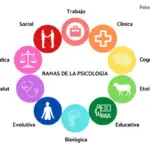
We can affirm that scientific psychology was the product of the philosophical interaction and the physiology of the nervous system, particularly the sensory one, with Germany being considered its “cradle” to later make its way to other countries in the world. Below, in PsicologíaOnline we detail all the aspects about the establishment of scientific psychology.
Wundt, Wilhelm – the foundation of scientific psychology in Germany
The goal of psychology is study of “conscious processes” or what Wundt (Germany) considers part of the “immediate experience”. For Wundt, psychologists do not study the external world per se, they study the psychological processes by which we experience and observe the external world. Furthermore, they cannot separate themselves from their objects of study since they study their own conscious processes.
The tool of psychologists is experimental self-observation or introspectionthis being a rigidly controlled process, which is not limited to self-reports, but includes objective measures as well as reaction times and word association.
Wundt places psychology between the physical sciences and the natural sciences; Experimental and research methods similar to those of the physical sciences to document are used for psychological issues as an inductive, experimental science. Wundt’s approach is that of a scientist who uses experimental methods to study that life. Wundt believed that language, myths, aesthetics, religion, and social customs are reflections of our highest mental processes; For him, these processes cannot be manipulated or controlled, so it is not possible to study them experimentally, but rather through historical records and literature and through naturalistic observations. He also conceives a third branch of psychology that integrates its empirical findings with other sciences, scientific metaphysics. Wundt’s goal (expressed in the text) is the establishment of psychology as a foundational sciencewhich integrates the social and physical sciences.

Janet, Pierre – Paris school
He was one of the members of the so-called School of Paris, who followed in the footsteps of Ribot and Charcot. Janet works intensely on the Hypnosis as a way to study the “subconscious mind”, applying it in cases of hysteria, anticipating Breuer and Freud in the cathartic method. He develops the theory of total or partial psychological automatism to explain the amnesic behaviors observed in personality splitting. Insists on the notion of “field of consciousness” and its “narrowing” in the sick due to their psychological weakness. He divides neuroses into hysterias and picasthenias (a term created by him to replace that of neurasthenia). Hysterias are characterized by the “narrowing of consciousness” and picasthenias by obsessive ideas and compulsive behaviors.
Its method (referred to in the text) will be the use of suggestion and hypnosis to search for and modify pathogenic memories.
Galton – British school
In English psychology we must highlight the great darwinian influence (this short text demonstrates it) as well as the influence of philosophical psychology.
Galton expresses an open concern about the heritability of human abilities and their “power to produce a lineage of highly gifted men…”.
eugenics, a discipline dedicated to the improvement of the breed through the control of reproduction, emerged as a consequence of the social climate of the mid-19th century. Galton tried to defend its positive aspects. He applied numerous anthropometric tests to check the effect of heredity on individuals. (Creator London Anthropometric Laboratory). He introduced the application of statistical techniques to psychology. Thought was also an object of study, using the “free association” and creating word association tests”. In short, he was one of the pioneers in world psychology and founder of the psychometric-differential tradition.
James, William – American school
He was the father of American psychology, developing the philosophy of pragmatism. He starts from the pragmatist thesis that “perception and thought exist only with a view to behavior.” He applies the principle of functionalism to psychologychanging it from its traditional place as a branch of philosophy and placing it among the sciences based on the experimental method.
By defining the Consciousness as “Stream of Thought”, a consciousness that is not captureable, is opposed to Wundt’s theory, which considers it as an association of units or elements. Consciousness is personal, changing, continuous (although with ups and downs such as sleep) and selective. The approach to personal consciousness leads him to develop the theory of the Self.
Pavlov, Ivan Petrovich – Russian school
Russian physiologist who never accepted psychology as a natural science, but who greatly influenced 20th century psychology. He was the founder of Russian experimental psychology. Pavlov did not distinguish between the temporal nervous relationship of physiologists and the associations of psychologists, a fact that allowed both sciences to cohere through a substrate of similar neuronal functioning. He worked on conditioning and believed that all behavior can be explained by stimulus and response.
He method used by Pavlov (the text shows a short fragment) is that of the conditioned reflexes. These works on conditioned reflexes set the tone for generating the current model that explains these behaviors at the cellular and molecular levels.
Differences and coincidences between schools on scientific psychology
The french school maintains a position far from the experimentalist direction of the German school, as well as the associationism and atomism of the British school. The studies of the French school focus on the individual and their psychic processes.
The american school and the German school They define consciousness completely differently: “stream of thought” (James) and “set of experiences lived by a person” (Wundt). James was convinced that all activity is functional; By applying biological principles to the mind, he formulated the Functionalist Theory of mental life and behavior.
German experimental psychology can be assimilated to British evolutionism. Wundt (Germany) is considered the founder of general psychology (adult, normal and generalized mind) and Galton (England) is considered the foundation of individual psychology (individual differences in human abilities). Galton was the first to study individual differences and the development of mental tests. With regards to the methods used: the school german, Wundt, studies the mind in an objective and scientific way. He introduced measurement and experiment to this discipline, which until then had been a branch of philosophy; the school french, internal and external observation, fundamentally of the clinical and hypnotic method; the school american chooses the experimental and research method, coinciding on this point with the German school; the school british, introduces statistical techniques applied to psychology; and finally, school russianwill use the method of conditioned reflexes.
In short, we can observe a common objective for all schools, which is to provide psychology with a scientific and experimental approachpromoting it as a independent science.

History of mental illness. concept and treatment
He origin of mental illness It has to do with a common practice in Ancient Greececonsisting of marking slaves in a visible place to make them recognizable as inferior individuals.
The Classical Antiquity an explanation was given of the mental disorders from the disorders produced in the brain by homomoral imbalances. These paintings were associated with demonic possession, so it was essential to stay away from such people.
The Middle Ages He saw the mentally ill as sinners, worshipers of the devil who had to “pay” with suffering for their “weakness” and lack of Faith, and this type of explanation persisted until the end of the 16th century.
In the 17th and 18th centuries, mental or emotional disorders were considered a voluntary departure from reason that had to be corrected through confinement and severe disciplinary measures. In these centuriesThe mentally ill are locked up and removed from community life. The purpose of his isolation was not his treatment but to protect society from those who violated social norms. The criterion of animality marks madness in the 18th century. It is the zero degree of human nature: the madman is not sick, he is an animal. Therefore, taming and brutalization are the methods for dominating him. The inhuman practices of boarding schools (whippings, beatings, chains, abuse of all kinds) are justified by that free animality of madness, where man no longer exists. (Michel Foucault).
In the 19th century, the somatic explanations of mental illness; object of medical study, psychological disorders were considered as a brain dysfunction that should be the object of moral treatment according to the principles established by the French psychiatrist Philippe Pinel (1745-1826). A complaint is widespread among psychiatrists: crazy people and criminals are mixed in the same place. A new awareness of madness arises from the experience of confinement. It is not a humanitarian attitude towards the insane that causes them to be differentiated within the boarding schools: the mixture is an injustice for the other inmates. Madness becomes more and more individualized. From the initial chaotic space of the Middle Ages, where the crazy and the sane mixed, increasingly more refined practices of separation towards madness have been produced. However, the asylums of the time were true rotting dens of lunatics. The prevailing environment, far from favoring the good evolution of the patients, contributed to their decompensation and disorganization.
The 20th century is characterized by the introduction and development of psychoanalysis, the expansion of the nosological classification of mental illnesses initiated by Emil Kraepelin (1856-1926), the development of neurology, physiology and biochemistry, bases of the development of organicist psychiatry, the rise of psychopharmacology and finally the beginning of psychosociological conceptions of mental health and illness. Regarding the current situation, even the word mentally ill, mental patient, crazy, etc., continue to be associated with violence and crime, etc. These patients are seen as a kind of urban predators, violent and uncontrollable who, even under treatment, can explode, harming their peers, judging them on many occasions as irrecoverable, not productive for society, guilty for having this disease, lacking motivation or simply unable to withstand stress due to a character deficit.
The World Federation for Mental Health (WFMH) and the World Health Organization (WHO) work to demystify mental illnessand since 1992, celebrate October 10 as “World Mental Health Day.”
This article is merely informative, at PsychologyFor we do not have the power to make a diagnosis or recommend a treatment. We invite you to go to a psychologist to treat your particular case.
If you want to read more articles similar to The establishment of scientific psychology we recommend that you enter our Clinical Psychology category.








